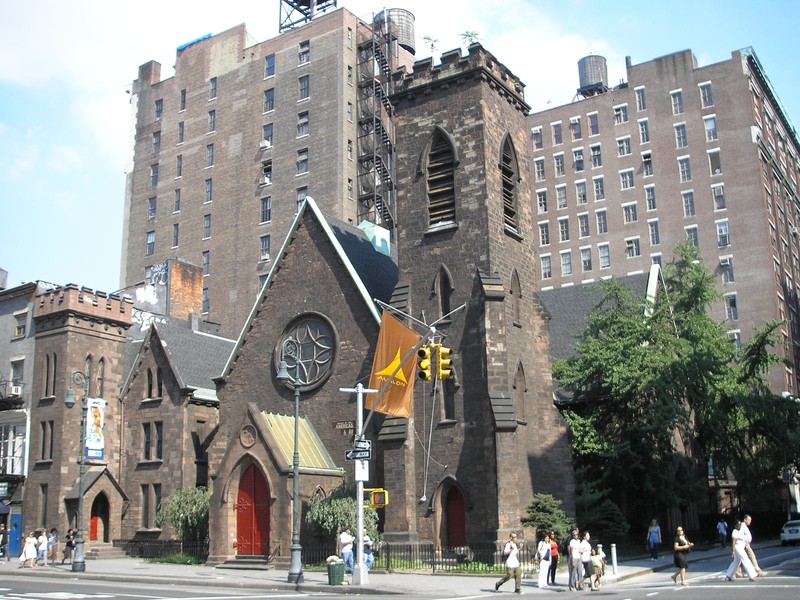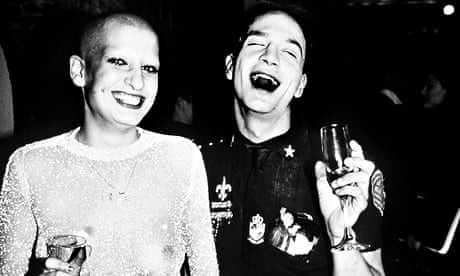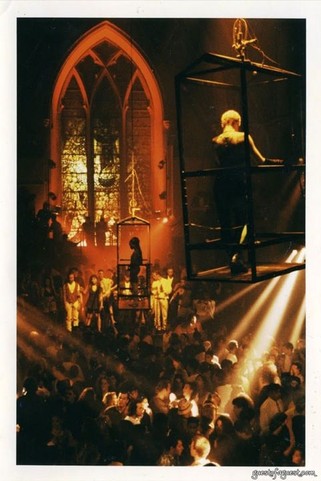Former Limelight Nightclub (Church of the Holy Communion)
Introduction
Text-to-speech Audio
Images
The former Limelight club

Michael Alig (dark shirt) and Genitalia

The dance floor at Limelight

Backstory and Context
Text-to-speech Audio
The Church of the Holy Communion was built in the mid-1800s and the church's Episcopalian congregation grew over the coming decades. The congregation faced declining membership in the 1960s when the surrounding Chelsea neighborhood saw a transition to urban development. The structure was named a New York City Landmark in 1966 shortly before the church was deconsecrated and the congregation moved elsewhere. In the coming years, the former church would undergo a number of incarnations, but because of its landmark status, the building would remain largely unaltered.
In the 1970s, as the neighborhood became ravaged by crime and the parish granted a 99-year lease to the Lindisfarne Association, a nonprofit cultural organization. For one dollar a year, the organization was able to rent the church to use for a host of educational and cultural events. Though the association was for a time a vital part of Chelsea, the costs of maintaining the building proved to be too much and the Lindisfarne Association left after only two years. The parish then sold the church to Odyssey House, a drug and alcohol rehabilitation center.
Odyssey House didn't last long in the building. In 1983, they sold the building to nightclub impresario Peter Gatien, who owned nightclubs in Atlanta and Miami. The prospect of a landmarked former church being transformed into a nightclub didn't sit well with many in the community, but some saw it as preferable to other developers who hoped to acquire the land and demolish the historic structure. The star-studded opening of the club, which Gatien named Limelight, was hosted by Andy Warhol, and for a time, the club was the place to be in Manhattan. Underneath the stained glass windows where the faithful once worshipped, sharp-eyed partiers might catch a glimpse of Prince, Pearl Jam, Mary J. Blige, RuPaul, Marilyn Manson, or Jay-Z.
But the club gradually developed a sinister reputation as a "drug marketplace" where heroin, cocaine, and ecstasy were bought and sold in copious amounts, generally to college students and young adults. Even among seasoned Manhattan clubgoers, Limelight's embrace of hedonistic excess and its indifference towards the safety of their patrons was shocking. Frank Owen, who has written about the 90s club scene in New York, said of Limelight that "it was like the last days of the Roman Empire." Tales of overdoses and sexual assaults in the formerly sacred space became alarmingly common.
As the clubs--several of them Gatien's--grew in popularity, so did a group of young artists and creatives known for their gender-bending, outlandish style. The "Club Kids," as they were known, became the influencers of their day, their over-the-top costumes and antics serving as a kind of promotion for one club or another. Limelight was heavily associated with the Club Kids, particularly Michael Alig, who functioned as a promoter for the club as well as a "leader" of the Club Kids movement.
By the time the Club Kids emerged, however, the drug scene in Manhattan clubs had evolved to "Special K" and heroin. In 1996, Alig and his roommate killed and dismembered a fellow Club Kid, Angel Melendez in a dispute over drugs. Alig, who would later claim to be so high on drugs that he could not remember the crime, reportedly sent out party invitations that jokingly referenced the murder. The notoriety surrounding the murder came at roughly the same time that former Mayor Rudy Giuliani became intent on shutting down the seedier elements of New York nightlife, and, faced with a massive investigation into drug sales at the club as well as mounting expenses, Limelight closed for good in 2007, after closing and reopening under another name. Alig served time in prison for manslaughter and Gatien was ultimately deported to his home in Canada.
Since its days as one of the city's most infamous nightclubs, the Limelight building has been both an upscale shopping mall and a gym. The club was the subject of a documentary titled "Limelight" and features prominently in the film Party Monster, which details the Melendez murder.
Cite This Entry
Woodham, Rebecca and Clio Admin. "Former Limelight Nightclub (Church of the Holy Communion)." Clio: Your Guide to History. October 11, 2020. Accessed March 24, 2025. https://theclio.com/tour/1562/1
Sources
Barrett, Paul . New York's Most Notorious Nightclub is Back Minus the Drugs but With More Lawyers, Bloomberg. September 1st 2016. Accessed October 5th 2020. https://www.bloombergquint.com/onweb/2016/09/01/new-york-s-most-notorious-nightclub-is-back-minus-the-drugs-but-with-more-lawyers.
Brockes, Emma. Michael Alig: "We Didn't Even Realize he Was Dead", The Guardian. June 21st 2014. Accessed October 5th 2020. https://www.theguardian.com/world/2014/jun/21/michael-alig-interview.
Krishna, Priya. From House of Worship to House of Sin: The History of Chelsea's Limelight Building , Curbed NY. November 30th 2016. Accessed October 5th 2020. https://ny.curbed.com/2016/11/30/13769350/limelight-building-chelsea-nyc-history.
Matos , Michaelangelo . 'Limelight': The Rise and Fall of the Church of Rave , NPR. September 26th 2011. Accessed October 5th 2020. https://www.npr.org/sections/therecord/2011/09/26/140804608/limelight-the-rise-and-fall-of-the-church-of-rave.

